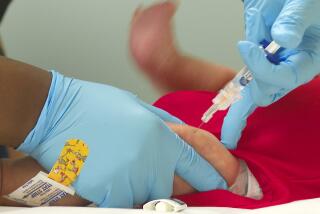Facts about whooping cough
- Share via
Whooping cough, also known as pertussis, is a bacterial disease that infects the respiratory system. It is most dangerous to infants, particularly those who are too young to be vaccinated.
Symptoms: Children and adults suffer from severe coughing, followed by the “whoop” sound made when the person inhales at the end of a coughing spasm. Young infants suffer a runny nose and slight cough but may not make the telltale “whoop” sound. Adults can also experience sweating episodes, severe coughing that worsens at night and a sense of choking.
Treatment: If diagnosed early, the disease can be effectively treated with antibiotics. But a delay in treatment can result in a three- to four-month illness. Young infants can become gravely ill rapidly, and health officials recommend that those with even very early symptoms be treated with antibiotics. They also say that doctors should strongly consider hospitalizing them in a facility with access to an intensive care unit.
Prevention: Because very young infants are too young to be vaccinated, officials recommend the “cocoon” strategy — making sure the expectant mother, father, grandparents, family members and anyone else in contact with the infant all have their pertussis inoculations up-to-date. Immunity can begin to fade five years after an inoculation.
Vaccination: The pertussis vaccine for infants and children is in the DTaP inoculation, which also protects against tetanus and diphtheria. There are five scheduled doses; one at 2 months, 4 months, 6 months, between 12 and 18 months and the last when the child is between 4 to 6 years old.
Adolescents and adults, including the elderly, can be vaccinated for pertussis with a different vaccine, known as Tdap.
(This fact box has been updated to reflect new recommendations by the California Department of Public Health, which now recommends the Tdap vaccination for senior citizens. Previously, the recommendation was for adolescents and adults through age 64.)
Sources: Dr. James D. Cherry, Textbook of Pediatric Infectious Diseases, U.S. Centers for Disease Control and Prevention, California Department of Public Health





